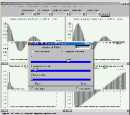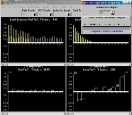|

DspEdu 2.1 is an Educational Software Package in DSP with Six Modules Covering 1. Linear Convolution of Two Finite Duration Sequences 2. Circular Convolution of Two Sequences 3. Linear Convolution from Circular Convolution 4. FFT and Sampling of Fourier Transforms 5. Spectral Analysis of Periodic Continuous Waveforms by FFT 6. FIR Filter Design by Windowing 7. IIR Filter Design by Analog to Discrete Transformation 8. Discrete-Time Transfer Function Pole-Zero Analysis.

This Site also contains a growing collection of Technical Articles written by Suresh Kumar K.S on topics in Electrical Engineering.

Home
Convolve Module
More on Convolve Module
FFT Module
More on FFT Module
Spectral Analysis Module
More on Spectral Analysis Module
FIR Filter Module
More on FIR Filter Module
IIR Filter Module
More on IIR Filter Module
Transfer Function Module
More on Transfer Function Module
My Technical Articles
Electrical Power Systems
|
From Home Page of Suresh Kumar K.S , Assistant Professor in Electrical Engineering
National Institute of Technology Calicut , Kerala State , India
|
DspEdu
v2.1 - FFT Module
  
|
|
The "FFT" Module of DspEdu Covers DFT by FFT Algorithm for real and complex discrete-time finite duration sequences , Inverse DFT of real and complex discrete-time sequences , undersampling of fourier transform of a real or complex discrete sequence and effect of undersampling on the reconstructed time-domain sequence etc.
DspEdu 2.1 is a Perl/Tk GUI program for Windows Platform to
help Students of Digital Signal Processing at Engineering Undergraduate
level in learning introductory DSP and experimenting with basic concepts
of DSP. Course Instructors will also find the program of help in enhancing
the effectiveness of their lectures by using the plot displays from this
program.There are six modules under this program at present. More modules
will be added in future and these modules will also undergo revision.
|
This module assists the student of
DSP in his study of the DFT of Finite Duration Sequences and to examine
the relationship between spectral sampling and time-domain aliasing in
such sequences. There are 10 examples coded in the program. In addition,
user can create, edit and save sequences as project files which can be
subsequently loaded into the module. The FFT computation results can be
saved into text files and the plots can be saved in Postscript format.
This module also allows the user
to calculate and display samples of Fourier Transform (sample number less
than the length of sequence) of finite duration sequences and to examine
the relationship between inverse DFT of such samples and the original data
sequence. A comparison of Fourier Transforms of the original sequence and
the aliased sequence also can be performed.
This module allows the user to generate the discrete-time sequences for FFT analysis and IFFT analysis by using a sequence generation window.It is also possible to generate the study sequences by typing in values and indices in the main window. Cursor support with read-out is provided in all sequence plots.It is possible to view the sequence plots in drop-line mode or line-join mode.
Click on the pictures below for high resolution screenshots of this Module or click on the link below to get more information on this Module.
 

|
Download Information
|
| DspEdu 2.1 is a Shareware. A feature
limited evaluation version is avilable for download from WinSite.Follow
the link below for the download file.
Download
Evaluation Version of DspEdu 2.1
The setup file installs the program
files , default project directories and the required Perl files and modules
under C:\DspEdu by default.DspEdu uses the Perl which gets loaded under
its installation directory even if the target system has Perl installed
in it. However , it does not affect the existing Perl installation , if any. Neither
does it modify any system settings or system files like autoexec.bat, system.ini,
win.ini etc.
The evaluation version allows 15 sessions for each module and each session is time-limited to 10 minutes. There are no feature-limits in the evaluation version.
|
|
Registering DspEdu 2.1 |
|
The Main Control Panel of the program
has a 'Register DspEdu' button. Clicking on this brings up a dialog box.
Enter the Serial Number and the corresponding Key in the entry boxes provided
for the purpose and click on the OK button to register the program. Successful
registration creates a license file in the installation directory.
You can obtain the Serial Number
and Registration key from RegSoft.

Student users from India can contact me over email for other payment options in INR and discount options.
|
Contact
Information
Suresh Kumar K.S
Assistant Professor in Electrical
Engineering
National Institute of Technology
Calicut,
Calicut-673601,Kerala,India
email - sureshks (at) nitc (dot) ac (dot) in
Home Page - My
Official Home Page
Phone - 91-0495-2286334 |
|
|
Page Updated
on 3rd May 2004
|
© 2004 Suresh
Kumar K.S
|

